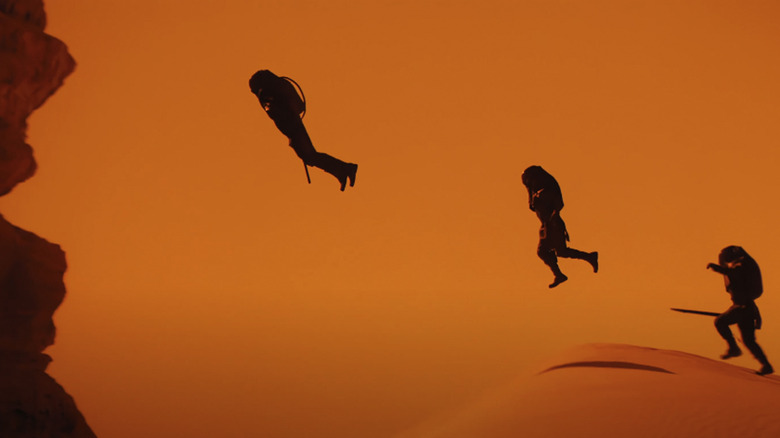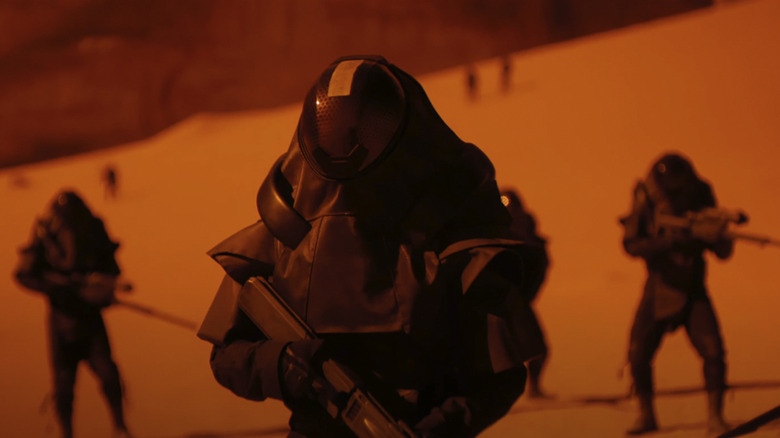Dune: Part Two's Anti-Gravity Attack Is 'Peak Sci-Fi' For Cinematographer Greig Fraser [Exclusive]
In the opening minutes of Denis Villeneuve's "Dune: Part Two," Harkonnen hunters are searching for native Fremen warriors on the surface of Arrakis during an eclipse. The hunters quickly realize the Fremen have called a sandworm to devour them, so they engage their anti-gravity jet packs and soar off the dunes up onto a huge rock formation to avoid being eaten. It's a simple-enough looking action — we've seen jet packs on screen plenty of times before — but something about the tangibility of the effect combined with Hans Zimmer's score, the desert location, and the stunning orange lighting that looks distinct from any other part of the film caused me to whisper "wow" in my theater seat. By the time the Harkonnens realize it's a trap and they're being picked off one by one, it's too late.
In honor of today's release of the 4K UHD disc of "Dune: Part Two," I had the pleasure of speaking with cinematographer Greig Fraser about the film, and I asked him how he achieved the look of this jaw-dropping opening action sequence.
"Denis and I were talking about how to open the movie," Fraser explained. "We talked about doing it at night, we talked about doing it day-for-night, we talked about doing it during the day, and all of those things just didn't sit well. We just went, 'This is not —', I mean, we put ourselves in the audience's seat and went, 'OK, we've bought the popcorn, we're drinking the Coca-Cola, come on, you've gotta show us what you've got, guys.' We thought, well, if we start the same way that the last one finished, with that look, it felt a little bit, eh, not right."
"So we were playing with all of those different things, and I found a filter that cuts out a number of light rays," he continued. "I've been playing with, particularly in Giedi Prime, with infrared and cutting out red, green, and blues, and cutting out different spectrums of light to come up with different looks. That's effectively what filters do: Filters cut a lot of spectrums of light. But I had a variable filter which took out just enough blue that you could get a little bit of blue in the sky, but it was mostly orange-y or red, and it had the right element of shadow detail. So we chose to use this filter, and we chose to make it deeper and darker as the story went on and as the eclipse became more heavy."
The color of Dune: Part Two's opening attack was due to the filmmakers trying to top themselves
Fraser is well-known for his pioneering work with The Volume, the LED stage technology that has revolutionized the way "Star Wars" projects are made these days. But "Dune: Part Two" is notable for not using that technology, and instead coming up with more tactile ways to immerse audiences into its alien worlds. And when it comes to immersion, dropping audiences into this orange-drenched eclipse and re-establishing the life-and-death stakes between these invaders and the Fremen was a perfect way to not only re-introduce audiences to this universe, but to create something visually ambitious that looked distinctly different than anything in the previous film. Fraser continued:
"We started that way because we knew it was a great way to start the film and a great way to launch this journey. And also, seeing those Harkonnen with those fantastic suits, with their voices and the anti-gravity, seeing all of that stuff in that color, that's peak sci-fi for me. That's the sci-fi I remember as a kid [...] I love that sort of sci-fi."
You and I both, sir.
Check out my whole conversation with Greig Fraser on today's episode of the /Film Daily podcast, which you can listen to below:
You can subscribe to /Film Daily on Apple Podcasts, Overcast, Spotify, or wherever you get your podcasts, and send your feedback, questions, comments, concerns, and mailbag topics to us at bpearson@slashfilm.com. Please leave your name and general geographic location in case we mention your e-mail on the air.

